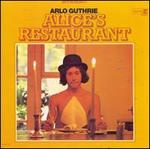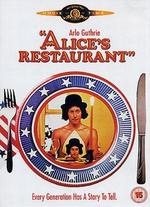I realized a little after 12 noon this Thanksgiving that Arlo Guthrie has had a much broader cultural impact in terms of bringing a progressive message to the general population than his father, Woody Guthrie. As a reader of this post is probably aware, across the radio dial across the United States, it is a tradition to play Arlo Guthrie’s song, Alice’s Restaurant at 12 noon on Thanksgiving. This tradition has been going on for four decades. We are not just talking about the anti-war song being played on granola-crunchy college radio stations. I listened to Alice’s Restaurant on a Clear Channel owned classic rock station that won’t even play Imagine most of the year. The DJ announced and dedicated the song as a favorite Thanksgiving tradition of a recently deceased listener. No mention was made of the song’s lengthy anti-war message. The song had transcended into a widely-celebrated annual tradition for the general population who never expresses a sentiment about war for the rest of the year.
[youtube=https://www.youtube.com/watch?v=b8DtpdXZi0M]
I was struck by the broad appeal of an anti-war song as a popular holiday tradition because I have been thinking increasingly about how to communicate a progressive message through the blockade put-up by the corporate media. As media in the US has undergone increasing corporate consolidation, art forms with a progressive message have been increasingly locked out. The small number of corporate owners of the majority of media pretend that progressive messages, like anti-war, just don’t exist. This corporate media will not do straight news on progressive ideas, much less allow art forms with those ideas to be presented. The new blacklist is enforced with an aggressiveness that would make the Smothers Brothers cringe.

I am so focused on art as a communication channel for progressive ideas because I hold the belief that change only happens when an idea travels beyond the arena of political discussion into the realm of cultural existence. Art, be it music, movies or books, have the power to bridge that gap. Art serves the function that Justice Thurgood Marshall did in the Supreme Court. In addition for being respected as the brilliant architect of the litigation strategy of the civil rights movement, justice Marshall was know on the court for bringing humanity to the decisions the Supreme Court was making. While he could easily match the other Justices on matters of legal interpretation, Marshall also brought to the table the powerful ability to explain how the decisions would affect the lives of ordinary people. Art also serves to humanize political decisions. It can cut through rhetoric to reach the real people impact of ideas.
Now I realize that Arlo cannot take credit for the noon-time Thanksgiving tradition that spread nationwide, but he did create a singular piece of art that has held up as a tradition over 40 years. I want to see what lessons we can take away from the art he created:
- Follow your muse, not the crowd. We should start with the most outstanding feature of the song — its length. Popular wisdom is that radio station managers will not allow any song over 3 1/2 minutes to be played. The original album version of Alice’s Restaurant is 18 1/2 minutes. (Live versions can vary considerably.) The song should never have been played on the radio based on conventional wisdom. In fact, originally the song was played by DJs during every shift on Thanksgiving, then cut down to midnight before, noon, and midnight of. Now it has been cut down to just noon. so in some ways, the pressure of radio station managers did cut down its airplay, but they also strengthened the tradition. Now a listener is a busy radio market can go up and down the dial to see how many different stations are playing it. Now some might argue, that DJs have a personal stake in playing a long song. The song’s length gives a chance to eat a sandwich, go for a bathroom break, or just take a breather. One must still acknowledge that the potential benefit of the song’s length to DJs only came out of Arlo’s courage to follow his muse in writing a song that ignored commercial expectations as to length.
- Start where audience is, not where you want them to be. The whole beginning of Alice’s Restaurantis about a small business owner, a Thanksgiving dinner, and taking out the trash. It is not about the war and opposition to it. The song introduces an anti-establishment theme through the ridiculous arrest and proto-CSI investigation. It quickly follows that episode up with something everyone — leftovers. Or in Arlo’s words: “Alice came by and with a few nasty words to Obie on the side, bailed us out of jail, and we went back to the church, had a another thanksgiving dinner that couldn’t be beat, and didn’t get up until the next morning, when we all had to go to court.” Only after taking us through this familiar territory, does the song shift gears after 10 stanzas of holiday celebration. Arlo even makes sure to that the transition comes quickly on the heels of the story we have been following: “And we was fined $50 and had to pick up the garbage in the snow, but thats not what I came to tell you about.//Came to talk about the draft.“
- Give your audience something familiar to hold on to all the way through. The chorus of Alice’s Restaurant is easy to remember, easy to sing, and non-threatening. It does not mention the war at all. It is about a small business and food. In fact, it is the most familiar type of music in the modern US: a commercial jingle. That’s what the chorus was originally written for, to be a radio commercial for the restaurant. As the story in the song becomes uncomfortably surreal, anti-establishment or anti-war, the listener knows it will return to the safety of the chorus. And the coup de grace is that at the end of the song, Arlo turns that safe chorus into a symbol of anti-war protest and the rallying cry for a movement.
- Humor. No one wants to be preached at, but everyone wants to be entertained. No one wants to talked down to, but everyone is more than willing to laugh at the leader’s foibles. Everyone would rather laugh than cry. Arlo asks the listener to laugh at him, and along with him. He doesn’t ask them to join his choir, only to sing along in the chorus. Like another great work of art, the film Casablanca, the song Alice’s Restaurant seems to be filled cliches but that is only because its filled with humorously memorable lines that seem like they existed forever. My personal favorite: “took shovels and rakes and implements of destruction.” Toward the end of the song Arlo interacts with the audience in order to assure that they are drawn into the song. He exhorts them to sing the chorus better in a way that reminds me of another folk singer of that time, Harry Chapin singing 30,000 lbs of Bananas. As mentioned above, Arlo turns the audience’s enthusiasm for singing the non-political chorus into a political action: “That was horrible. If you want to end war and stuff you got to sing loud. I’ve been singing this song now for twenty five minutes. I could sing it for another twenty five minutes. I’m not proud… or tired.// So we’ll wait till it comes around again, and this time with four part harmony and feeling.”
- Use familiar tools. Arlo is able to keep his audience’s attention in Alice’s Restaurant for 17 minutes by doing more than telling 2 amusing stories. He also uses every literary device he can lay his hands on. Assonance, amplification, archetype, authorial intrusion, Bildungsroman, Caesura — You get the idea. Though we have discussed that Arlo did not feel bound by conventional wisdom, he was smart enough to realize that storytelling tools provide the narrative framework. Other people went to all the work of creating and honing them. Feel free to use them liberally.
Related articles
- You can get anything you want: Peace Song for 11/26/2011
- Arlo Guthrie, Pete Seeger and families at Carnegie Hall








